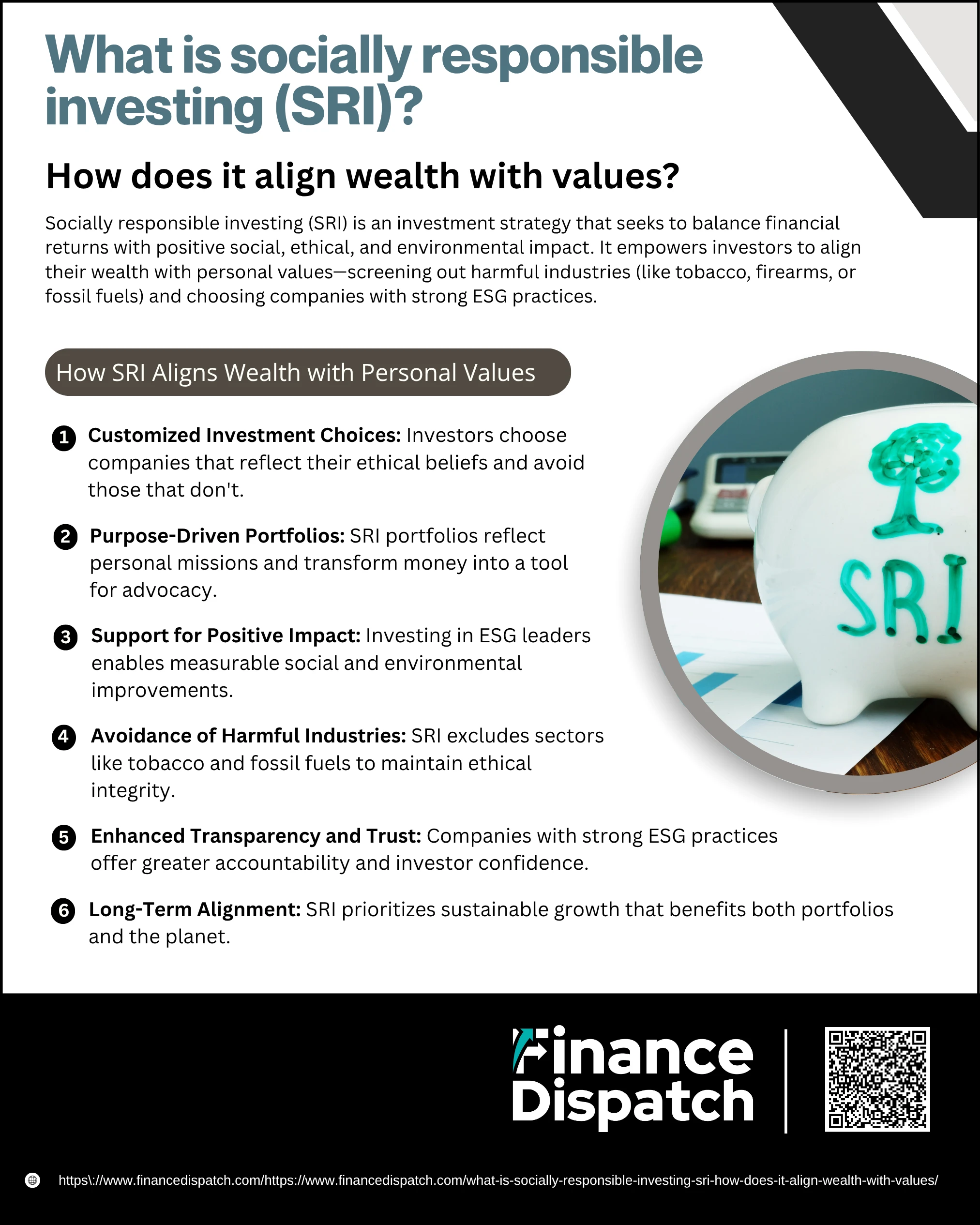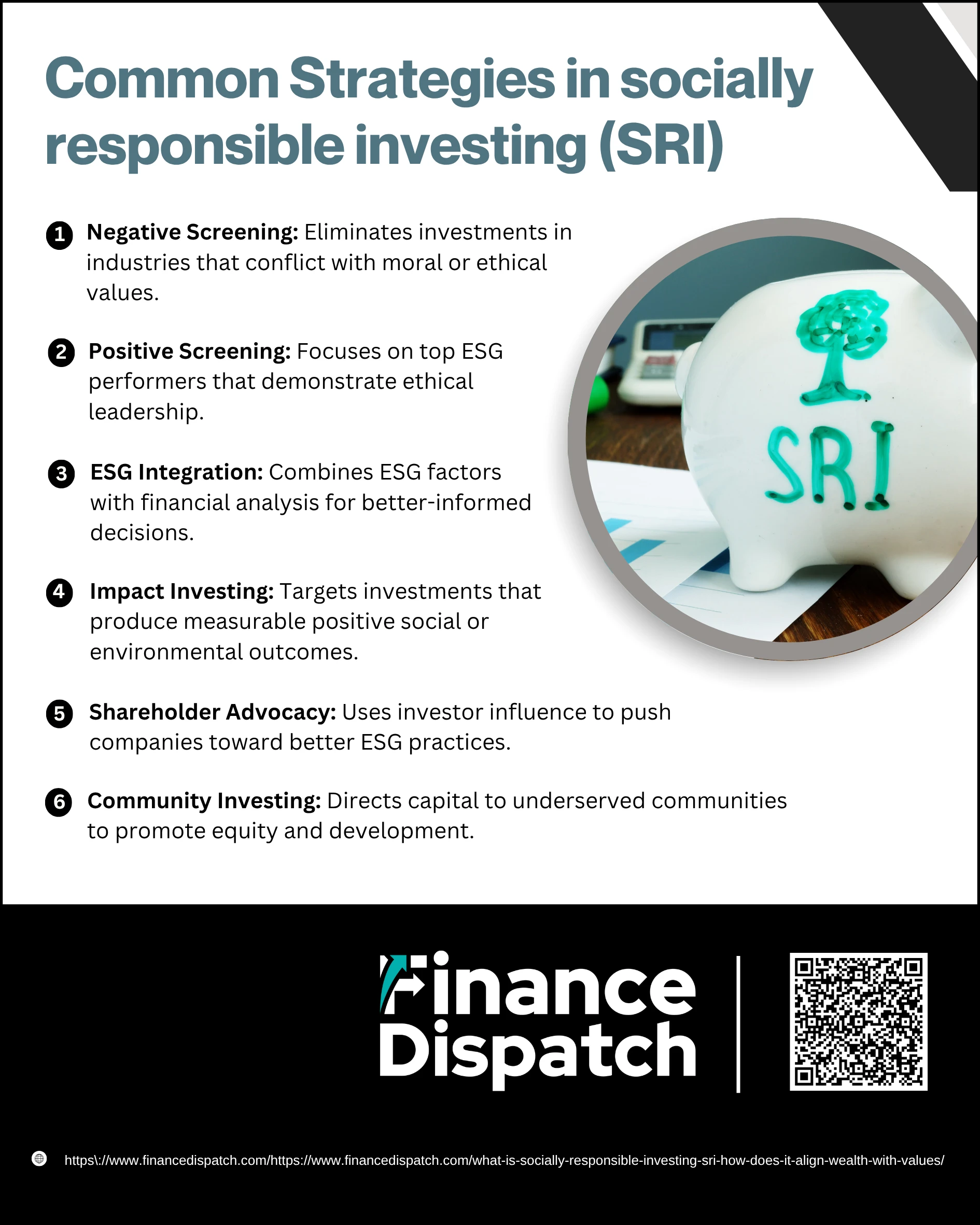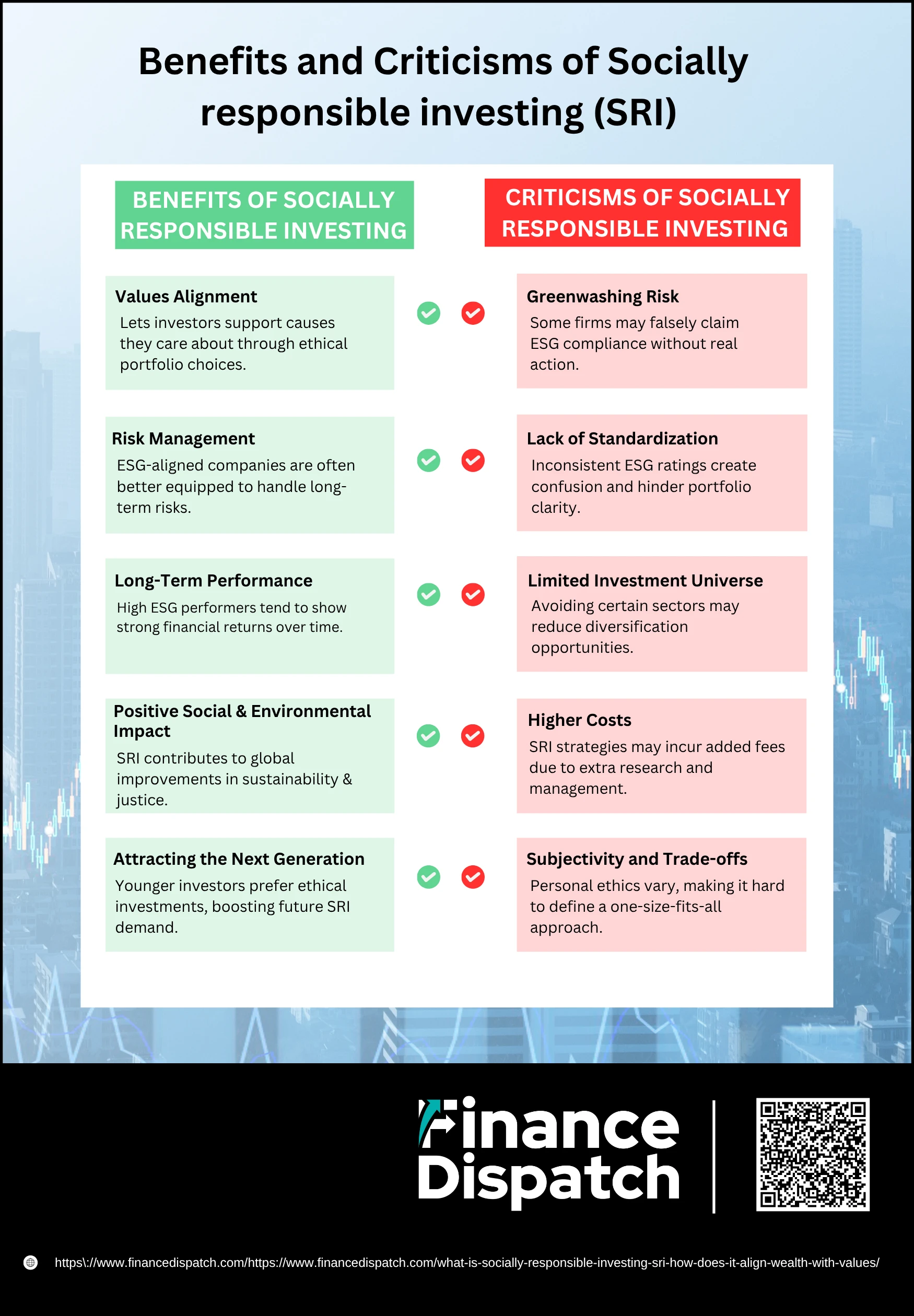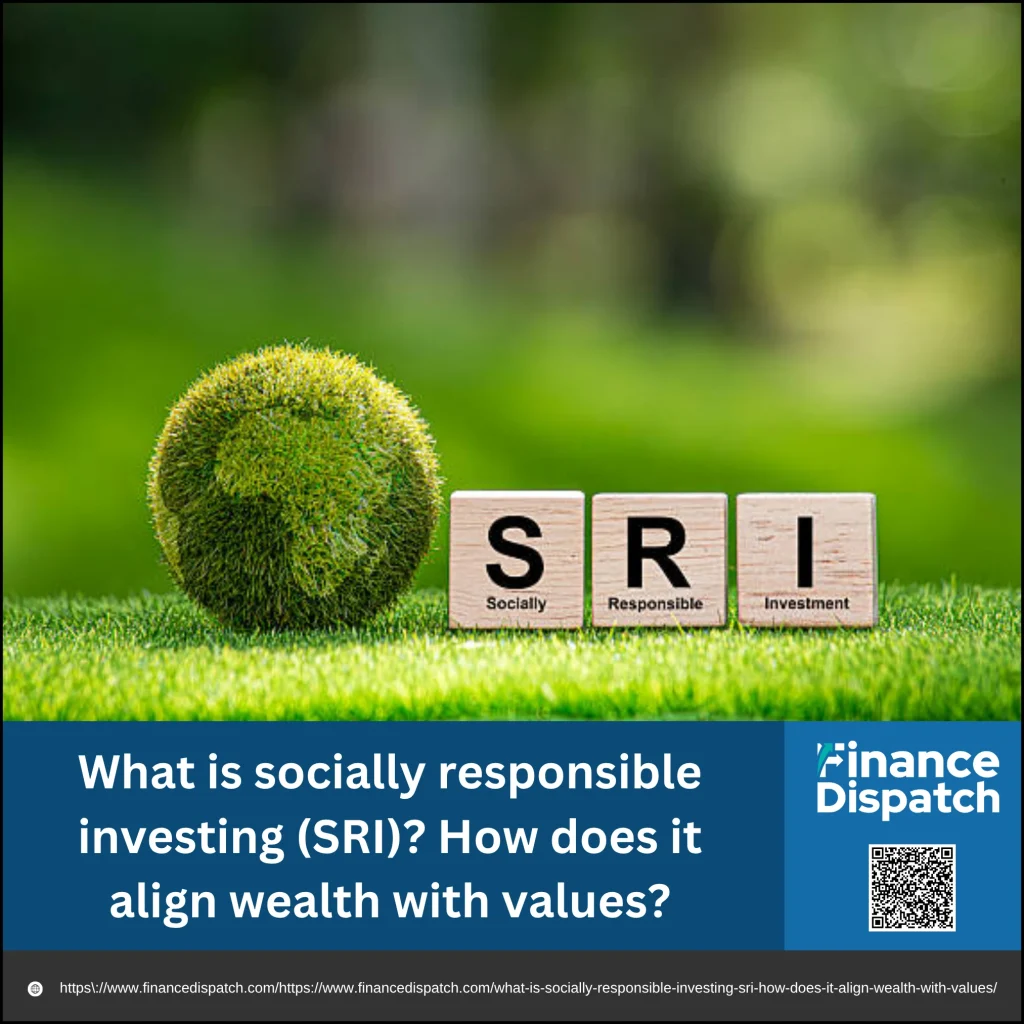In today’s investment landscape, more individuals and institutions are seeking ways to grow their wealth without compromising their values. This shift has given rise to socially responsible investing (SRI), a strategy that merges financial performance with ethical and sustainable considerations. Rather than focusing solely on profits, SRI emphasizes investments in companies and projects that demonstrate positive environmental, social, and governance (ESG) practices. By aligning capital with causes like climate action, human rights, and corporate accountability, socially responsible investing empowers investors to support meaningful change while still pursuing long-term financial goals.
What is Socially Responsible Investing (SRI)?
Socially Responsible Investing (SRI) is an investment approach that considers both financial return and social or environmental good to bring about a positive change. It involves selecting companies or funds not only based on traditional performance metrics but also on how well they align with specific ethical principles. At the heart of SRI is the use of Environmental, Social, and Governance (ESG) criteria, which help investors evaluate a company’s impact on the planet, its treatment of people, and its internal ethical practices. Whether through avoiding harmful industries like tobacco and fossil fuels or actively investing in clean energy and fair labor practices, SRI enables individuals and organizations to ensure their money supports causes that reflect their personal or institutional values.
Core Components of SRI
At its foundation, Socially Responsible Investing (SRI) is guided by principles that prioritize ethical integrity alongside financial performance. Investors use a set of criteria to evaluate and select companies that demonstrate responsible behavior in key areas. These core components serve as the pillars of SRI, helping ensure that investments align with broader societal and environmental values.
Key Components of SRI:
1. Environmental Responsibility: Evaluates a company’s impact on the planet, including carbon emissions, pollution control, renewable energy use, and sustainability initiatives.
2. Social Impact: Assesses how a company treats its employees, supports human rights, embraces diversity, and engages with the communities it operates in.
3. Corporate Governance: Focuses on internal practices such as executive compensation, board diversity, transparency, and ethical decision-making.
4. Negative Screening: Involves excluding companies or sectors that conflict with specific ethical standards, such as those involved in weapons, tobacco, or gambling.
5. Positive Screening: Proactively includes companies that excel in ESG practices and lead in sustainability or social innovation.
6. Community Investing: Directs capital to underserved areas or social enterprises, supporting affordable housing, small businesses, and economic development.
7. Shareholder Advocacy: Engages investors in influencing company behavior by voting on shareholder resolutions or initiating dialogues with company leadership.
 How SRI Aligns Wealth with Personal Values
How SRI Aligns Wealth with Personal Values
For many investors, building wealth is no longer just about returns—it’s about making a difference. Socially Responsible Investing (SRI) offers a way to align financial strategies with deeply held personal values. Whether it’s environmental stewardship, human rights, or ethical governance, SRI allows individuals to support causes they believe in while still working toward their long-term financial goals. Here’s how SRI helps connect money with meaning:
1. Customized Investment Choices
SRI enables investors to select specific companies, industries, or funds that align with their ethical standards. This means avoiding businesses involved in practices they oppose (such as child labor or environmental degradation) and prioritizing those that represent their personal ideals—like clean energy, fair trade, or animal welfare. This level of customization turns investing into a deeply personal and values-driven act.
2. Purpose-Driven Portfolios
A purpose-driven portfolio doesn’t just grow wealth—it tells a story about what the investor stands for. Whether the goal is to advance climate solutions, promote diversity and inclusion, or support healthcare access in underserved areas, SRI allows individuals to align their money with missions that matter to them, turning financial decisions into a form of advocacy.
3. Support for Positive Impact
By investing in companies with high ESG ratings, individuals help channel capital toward businesses that prioritize sustainability, ethical supply chains, human rights, and responsible leadership. This proactive support contributes to measurable improvements in society and the environment—often referred to as “impact investing.”
4. Avoidance of Harmful Industries
SRI also includes negative screening strategies to filter out companies or sectors that contradict an investor’s values. This might include industries like fossil fuels, weapons, tobacco, or gambling. By steering clear of these investments, investors maintain a portfolio that reflects their personal integrity and avoids contributing to social or environmental harm.
5. Enhanced Transparency and Trust
Companies that meet SRI and ESG criteria are typically more transparent, disclosing information on their environmental impact, labor practices, and governance policies. This openness builds trust and gives investors confidence that their money is supporting ethical, accountable organizations that align with their principles.
6. Long-Term Alignment
SRI is rooted in sustainability, which often means focusing on the long-term health of both the planet and portfolios. Ethical companies that prioritize risk management, compliance, and stakeholder relationships are often better positioned for stable, long-term growth. This approach aligns well with investors who seek not only financial returns but also enduring positive change over time.
 Common Strategies in SRI
Common Strategies in SRI
Socially Responsible Investing (SRI) isn’t a one-size-fits-all approach. Investors can adopt various strategies to tailor their portfolios according to personal ethics, societal concerns, or environmental goals. These strategies help screen investments, promote responsible corporate behavior, and maximize both financial and social returns. Understanding these core approaches is essential for anyone looking to integrate values into their investment process.
1. Negative Screening
This strategy involves excluding companies or industries that engage in activities considered harmful or unethical—such as tobacco, firearms, fossil fuels, or gambling. It’s one of the oldest and most widely used SRI methods, allowing investors to avoid profiting from sectors that conflict with their values.
2. Positive Screening
Also known as best-in-class screening, this approach focuses on selecting companies that excel in ESG performance relative to their peers. Investors actively seek businesses that demonstrate leadership in sustainability, diversity, clean energy, or ethical labor practices.
3. ESG Integration
ESG integration weaves environmental, social, and governance factors into traditional financial analysis. This strategy aims to enhance investment decision-making by identifying risks and opportunities that conventional financial metrics might miss.
4. Impact Investing
Impact investing goes a step further by targeting investments that generate measurable social or environmental benefits alongside financial returns. Examples include funding affordable housing, renewable energy projects, or healthcare innovations in underserved communities.
5. Shareholder Advocacy
Investors use their ownership rights to influence corporate behavior through proxy voting, shareholder resolutions, and direct engagement with company management. This strategy empowers investors to push for transparency, policy changes, or better ESG practices within companies they’re invested in.
6. Community Investing
Community investing focuses on providing capital to underserved individuals or regions. This could include microfinance, small business lending, or infrastructure development aimed at promoting economic empowerment and reducing inequality.
Comparison of SRI vs. ESG vs. Impact Investing
Though often used interchangeably, Socially Responsible Investing (SRI), Environmental, Social, and Governance (ESG) investing, and Impact Investing each represent distinct approaches to ethical finance. While they share a common goal of aligning investments with values, they differ in methodology, focus, and intent. Understanding the differences between these approaches can help investors choose the strategy that best reflects their priorities and financial objectives.
| Feature | SRI (Socially Responsible Investing) | ESG (Environmental, Social, Governance) | Impact Investing |
| Primary Goal | Avoid harm and align with ethical values | Integrate ESG risks and opportunities into financial analysis | Generate measurable positive social or environmental impact with financial return |
| Approach | Values-based (exclusion/inclusion) | Data-driven, metrics-based | Mission-driven, outcome-focused |
| Screening Style | Often uses negative and positive screening | Uses ESG scores/ratings to evaluate investment risks | Targets specific projects or companies that solve social/environmental problems |
| Investor Intent | Align investments with personal or institutional values | Enhance long-term financial performance through ESG consideration | Actively create social/environmental outcomes while earning a return |
| Example | Exclude fossil fuel or tobacco companies | Invest in companies with strong ESG scores (e.g., sustainable supply chains) | Invest in solar farms, affordable housing, or microfinance initiatives |
| Measurement of Impact | General ethical alignment | ESG scores, risk metrics | Specific, quantifiable social/environmental outcomes (e.g., emissions reduced) |
| Flexibility | More rigid due to value-based exclusions | Flexible—can invest in companies improving their ESG efforts | Highly targeted, often requires deeper research and engagement |
| Typical Investor | Ethics-focused individuals or institutions | Risk-conscious and performance-oriented investors | Mission-aligned investors seeking dual returns (impact + profit) |
 Benefits and Criticisms of SRI
Benefits and Criticisms of SRI
Socially Responsible Investing (SRI) has gained mainstream attention for allowing investors to pursue financial returns while supporting causes they care about. From environmental protection to social justice, SRI offers a compelling blend of purpose and performance. However, like any investment strategy, it comes with both advantages and criticisms. Understanding both sides helps investors make informed, balanced decisions.
Benefits of SRI
1. Values Alignment
One of the core appeals of SRI is the ability to align your investment portfolio with your personal or organizational values. Whether it’s avoiding companies involved in child labor or actively investing in clean energy, SRI allows investors to put their money where their beliefs are. This creates a sense of fulfillment and purpose, knowing that your financial decisions support a cause you care about.
2. Risk Management
Companies that score well on ESG criteria often have better oversight, more resilient supply chains, and stronger stakeholder relationships. These traits can help reduce exposure to risks like lawsuits, regulatory penalties, environmental disasters, or consumer backlash. As a result, SRI portfolios may be better positioned to weather market volatility and long-term business disruptions.
3. Long-Term Performance
Contrary to the misconception that ethical investing comes at the expense of returns, numerous studies show that companies with high ESG ratings often outperform their peers over time. Sustainable practices tend to drive innovation, improve operational efficiency, and attract loyal customers—all of which contribute to long-term profitability and shareholder value.
4. Positive Social and Environmental Impact
SRI empowers investors to support companies and projects that actively contribute to social and environmental well-being. From funding renewable energy to supporting fair labor practices, your investments can be part of larger solutions to global issues. This impact goes beyond financial returns, creating measurable change in areas like clean water access, education, and climate action.
5. Attracting the Next Generation
Millennial and Gen Z investors are significantly more likely to choose ethical or sustainable investments. As these generations accumulate wealth, demand for SRI products is expected to rise. Advisors, firms, and institutions that integrate SRI into their offerings are more likely to appeal to this values-driven demographic and future-proof their portfolios.
Criticisms of SRI
1. Greenwashing Risk
A major concern in SRI is the potential for greenwashing—where companies exaggerate or falsely claim their commitment to sustainability. Without rigorous standards and third-party verification, some investment products may appear socially responsible while supporting companies with questionable practices. This can mislead well-intentioned investors and dilute the impact of SRI.
2. Lack of Standardization
ESG metrics are not universally defined, and ratings can vary significantly between data providers. One firm may give a company a high ESG score, while another may rank it poorly due to different evaluation methods. This inconsistency makes it difficult to compare options and complicates the screening process for investors trying to build a truly responsible portfolio.
3. Limited Investment Universe
By excluding entire sectors—like oil, tobacco, or defense—SRI may narrow the pool of investment opportunities. This can make it harder to achieve optimal diversification or capitalize on high-performing sectors that may not meet ESG criteria. For some investors, especially those seeking aggressive growth, this trade-off may be a sticking point.
4. Higher Costs
The additional research and active management required to maintain an SRI portfolio can lead to higher expense ratios or advisory fees. While there are low-cost SRI options available, investors should be mindful of fees that could erode returns, particularly in passively managed or index-based investment strategies.
5. Subjectivity and Trade-offs
Ethics are personal. One investor’s priority may be environmental protection, while another’s may be labor rights or religious considerations. This subjectivity makes it difficult to create universal SRI portfolios. Additionally, investors may have to choose between maximizing returns and staying fully committed to their ethical standards—leading to difficult trade-offs in portfolio construction.
How to Start with Socially Responsible Investing
Beginning your journey with Socially Responsible Investing (SRI) doesn’t require a complete overhaul of your finances—just a thoughtful approach to aligning your investments with your values. Whether you’re a seasoned investor or just starting out, taking the time to understand your priorities and explore responsible investment options can help you grow your wealth while contributing to positive change in the world. Here are key steps to get started with SRI:
1. Clarify Your Values and Goals
Identify the social, environmental, or ethical issues that matter most to you—such as climate action, diversity, animal welfare, or corporate transparency. Define what “responsible investing” means for you personally.
2. Understand SRI Strategies
Learn about the different SRI approaches: negative screening (avoiding harmful sectors), positive screening (selecting top ESG performers), ESG integration, and impact investing. This helps you choose a strategy that suits your financial and ethical goals.
3. Research SRI Funds and Companies
Explore mutual funds, ETFs, or individual stocks that meet your values. Look into third-party ESG ratings from sources like Morningstar, MSCI, or Sustainalytics to assess a company’s performance on key sustainability metrics.
4. Choose a Platform or Advisor
Decide whether you want to invest independently using a brokerage or work with a financial advisor or robo-advisor that specializes in SRI portfolios. Many platforms now offer pre-screened SRI investment options.
5. Start Small and Diversify
Begin with a manageable investment amount and spread your capital across various sectors and asset types to manage risk while maintaining alignment with your values.
6. Review and Adjust Regularly
Monitor your investments over time to ensure they continue to reflect your principles and financial goals. Stay informed about ESG trends and be open to adjusting your portfolio as needed.
Real-World Examples of SRI in Action
Socially Responsible Investing (SRI) isn’t just a theoretical concept—it’s actively shaping the strategies of major companies around the world. Many organizations have embraced ESG (Environmental, Social, and Governance) principles, integrating them into their business operations to drive both ethical impact and long-term value. These companies serve as powerful examples of how financial success can go hand-in-hand with sustainability, inclusion, and responsible governance. Below are some real-world examples of companies leading the way in SRI:
1. Tata Consultancy Services (TCS)
Known for its strong corporate governance and community engagement, TCS has implemented energy-efficient operations and supports educational and health initiatives across India.
2. Infosys
A leader in green IT, Infosys focuses on renewable energy, water conservation, and fostering workplace diversity and employee well-being.
3. Hindustan Unilever
The company’s sustainability strategy includes waste reduction, sustainable sourcing, and programs promoting health, nutrition, and hygiene.
4. Mahindra & Mahindra
Recognized for its contributions to renewable energy and rural development, the company also focuses on water conservation and sustainable agriculture.
5. Wipro
Wipro runs comprehensive programs in energy conservation, waste management, and education-based community development, reflecting its deep ESG integration.
6. HDFC Bank
With a strong focus on financial inclusion, HDFC supports rural banking, skill development, education, and environmental sustainability through its CSR initiatives.
7. Larsen & Toubro (L&T)
L&T emphasizes sustainable infrastructure, building energy-efficient structures and engaging in large-scale water conservation and community development efforts.
8. ITC Limited
ITC is deeply involved in sustainable agriculture, water stewardship, and health and education initiatives, with a business model focused on environmental responsibility.
9. Tata Steel
A pioneer in sustainable manufacturing, Tata Steel invests in energy efficiency, greenhouse gas reduction, and long-term community support programs.
10. Godrej Consumer Products
With a strong sustainability framework, the company promotes green manufacturing, responsible sourcing, and inclusive growth across its supply chain.
Conclusion
Socially Responsible Investing (SRI) represents a powerful shift in the way individuals and institutions approach wealth building—one that goes beyond profit to include purpose. By incorporating ethical values and ESG principles into investment decisions, SRI allows investors to support businesses that prioritize sustainability, social equity, and responsible governance. While it offers strong potential for long-term returns, it also empowers investors to contribute to meaningful change in the world. As awareness continues to grow and more tools become available, SRI is no longer a niche concept—it’s a forward-thinking strategy for aligning money with values and building a more responsible future.



